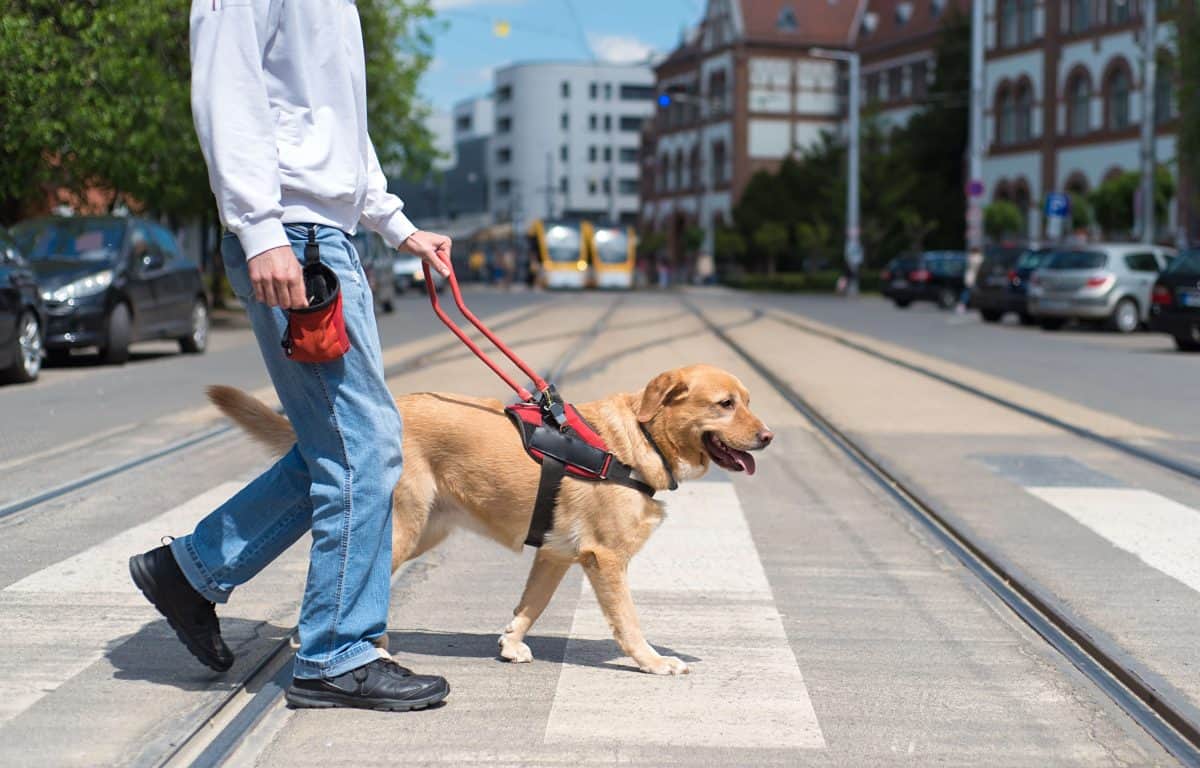10 Types of Service Dogs

Service dogs help individuals with disabilities or medical/mental health conditions live more independent lives. The areas dogs can assist are growing. This blog will discuss 10 types of service dogs and the skills needed to do the job.
Note that service dogs are different from Therapy Dogs or Emotional Support Dogs. To learn more about these categories, click here.
General Service Dogs
1. Mobility Assistance Dogs
One of the most common services dogs perform is various types of mobility assistance. This includes assisting in pulling a wheelchair or retrieving dropped items. It can also include providing physical support for a person with balance issues. The dog may help them up and down stairs or even helping them stand up if they’ve fallen.
Guide Dogs
2. Seeing Eye Dogs
These dogs are usually trained for 14-18 months. They begin training by living full-time with puppy raisers where they are taken everywhere to help socialize them to all the sights, sounds and smells of the world. In addition, they learn their basic obedience skills. At about a year old, they return to the training facility and learn how to help a blind person navigate the world.
They learn skills such as stopping at curbs, avoiding overhead obstacles and helping their person find door handles. One important skill is learning to ignore commands that could put the team in danger. Once trained, they’re paired with a blind person in need and the two go through a 2-4 week training program. The pairing is based on personality and temperament of both person and dog.
3. Hearing Ear Dogs
Next, we have Hearing Ear Dogs. These dogs are raised similarly to Seeing Eye Dogs; their skills training focuses on alerting to various sounds. These dogs keep their person from stepping off the curb if there is a car coming. They also alert to alarms, door bells/knocks, and other noises that could be relevant to the person. Once training is complete, they are matched to a person and go through a 2-4 week program to get to know each other. This is also the time when any special skills needed for that particular human can be taught.
Medical Assistance Dogs
4. Seizure Alert Dogs
These dogs appear to be particularly sensitive to chemical changes that occur before a person has a seizure. These dogs can be trained to alert the person so they can get somewhere safe before a seizure starts. This service is considered controversial. We do not yet have solid evidence that dogs can consistently recognize and acknowledge these markers. It’s also not something that can be trained. This requires a dog who seems naturally tuned to these subtle changes in their person.
5. Seizure Response Dogs
Less controversial is the Seizure Response dog. These Service Dogs are trained to stay close to their person during a seizure. They may also be trained to bark until help arrives or to find the nearest human and lead them back to their person.
6. Diabetic Alert Dogs
Diabetic Alert dogs detect spikes or dips in blood sugar based on the smell of sweat on their person. When these chemical changes are detected, the dog alerts the person so they can eat or take insulin as needed.
7. Psychiatric Service Dogs
These dogs help those coping with mental health issues. PTSD dogs help those suffering post traumatic stress disorder. They may be trained to walk ahead of their person or turn on room lights before their person enters.
8. Social Anxiety Dogs
Social Anxiety (SA) dogs may be trained to provide physical comfort when they sense their person is beginning to panic. Another common skill Social Anxiety dogs are taught is to give an alert that could pass for a need to potty – giving the person an excuse to leave without feeling awkward.
9. Sensory Signal (Social Signal) Dogs
Such dogs are trained to assist persons on the autism spectrum. A common skill for these dogs is to interrupt repetitive or self-injurious injuries common to some on the spectrum.
10. Allergy Alert Dogs
Finally, Allergy Alert dogs are taught to recognize the smells of items that will cause allergic reaction in their handler. Most commonly, this will be food items. But it may include anything with which the handler may come in contact. This isn’t for your mild allergies that might need an OTC allergy pill. People needing an allergy alert dog suffer potentially fatal allergic reactions.
Author - Jody Epstein
Jody Epstein is a certified behavior consultant, certified professional dog trainer, and holds a master’s degree in animal behavior from Tufts University. She has been training professionally for more than 12 years and is pleased to be part of the Academy of Pet Careers team, teaching the next generation of trainers. Look out for her blogs on all things dog training and animal behavior.

